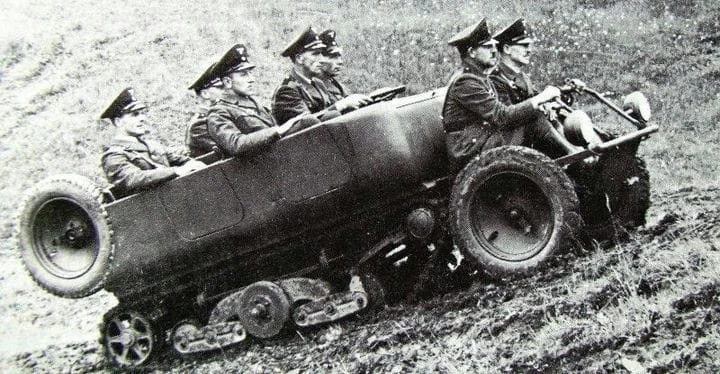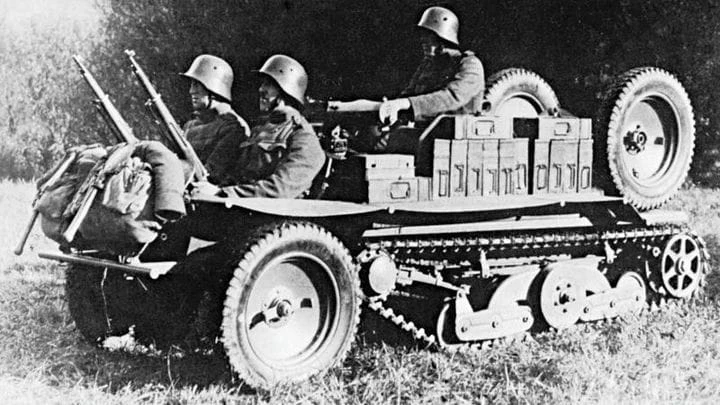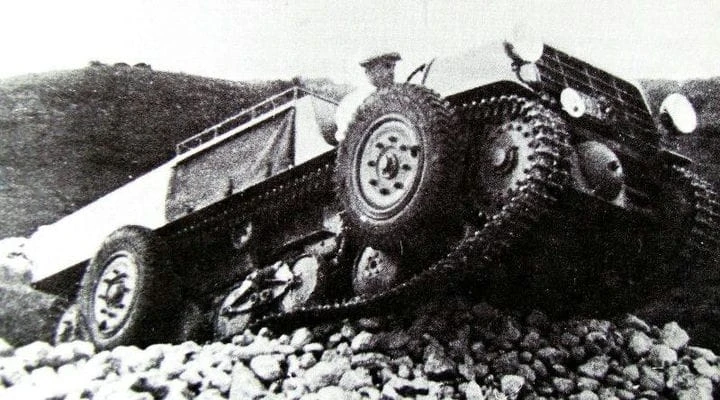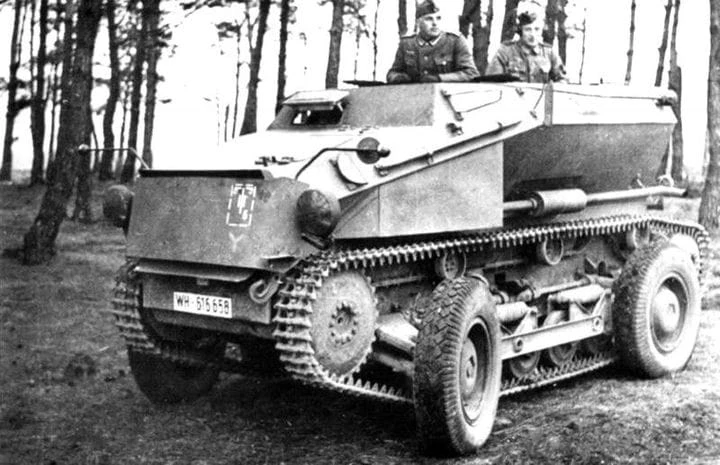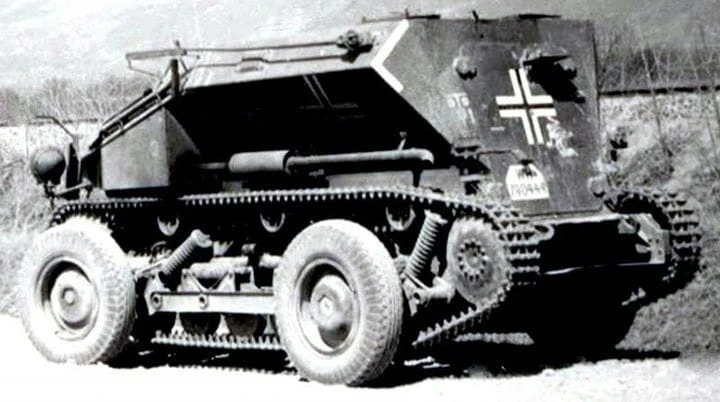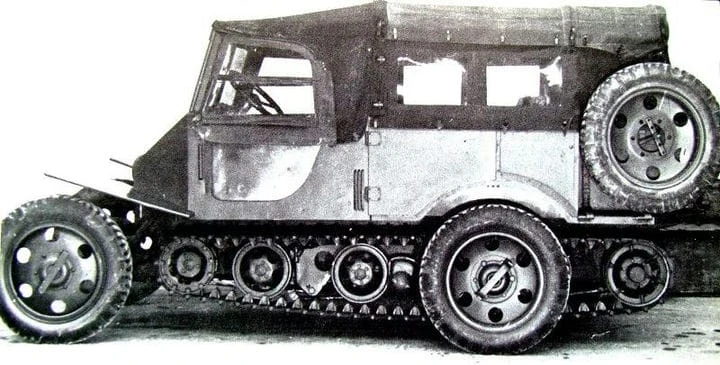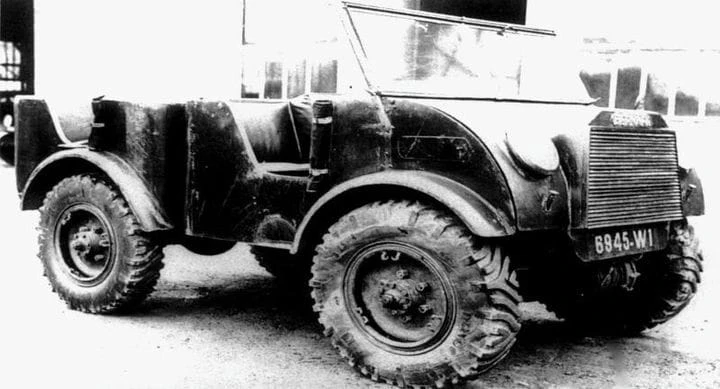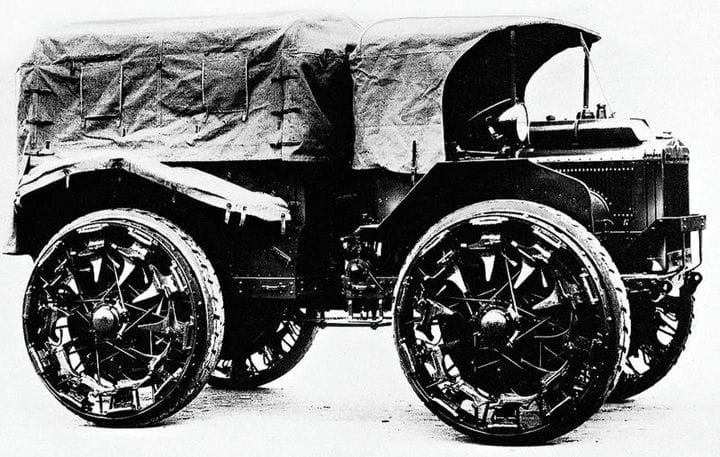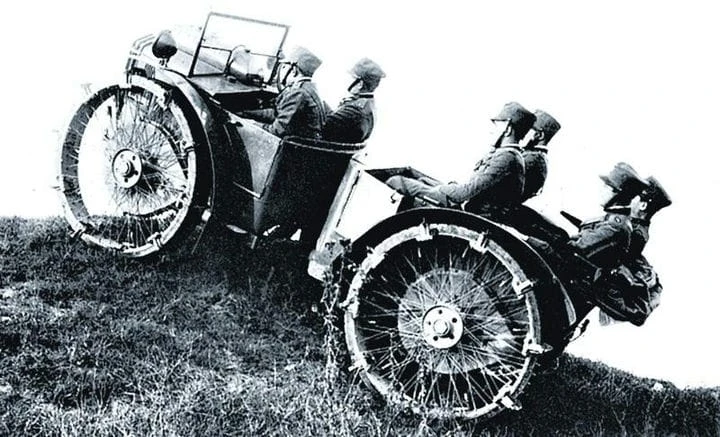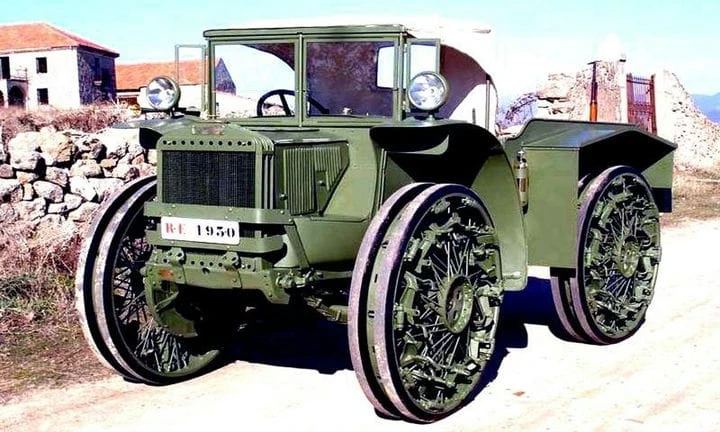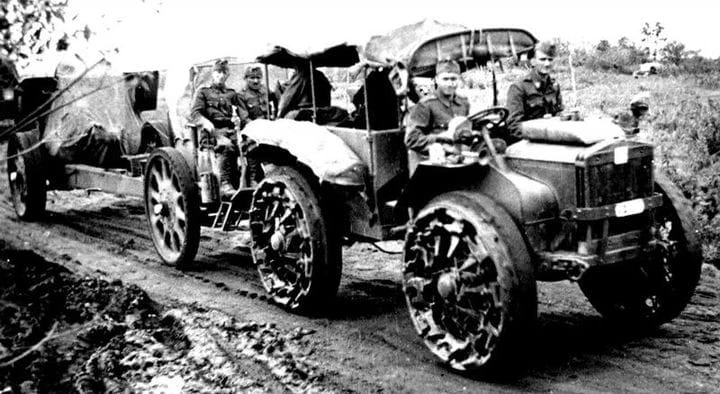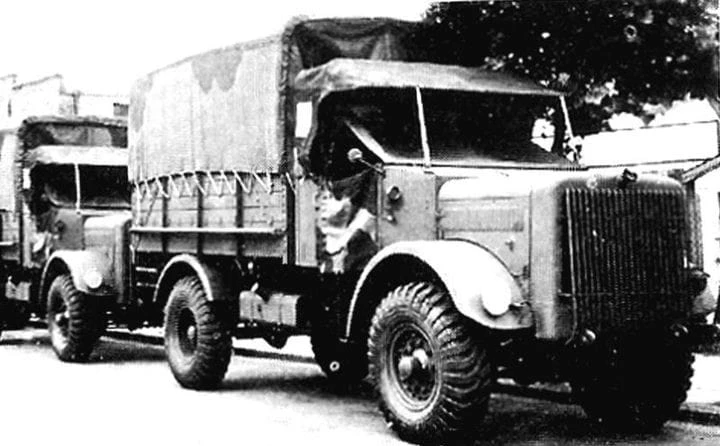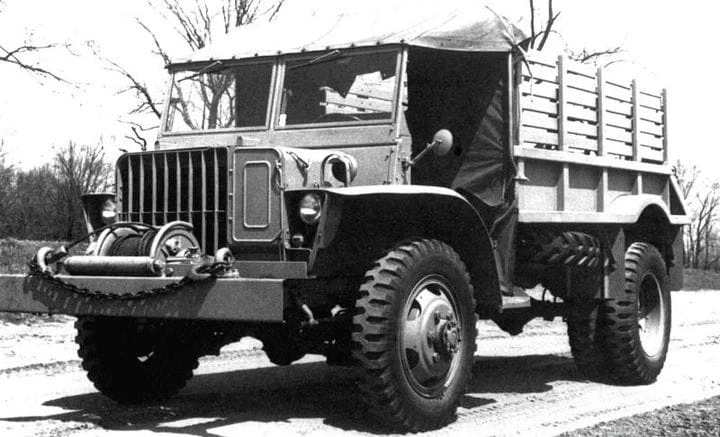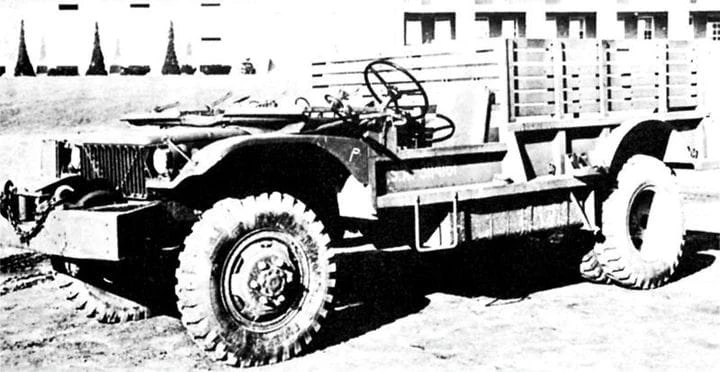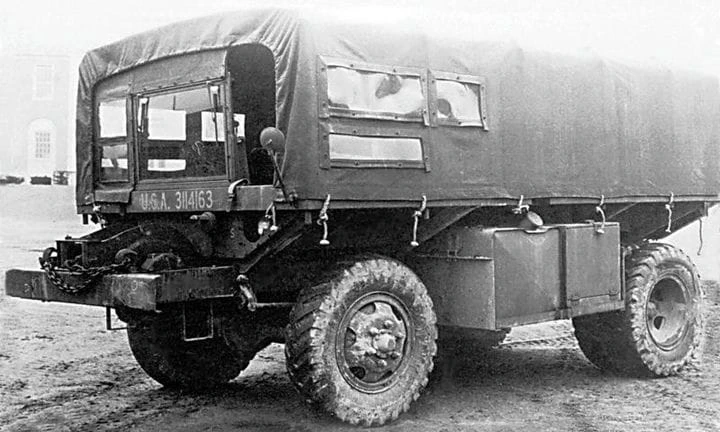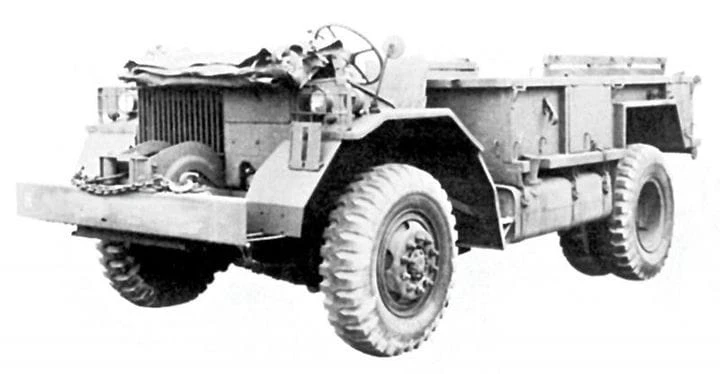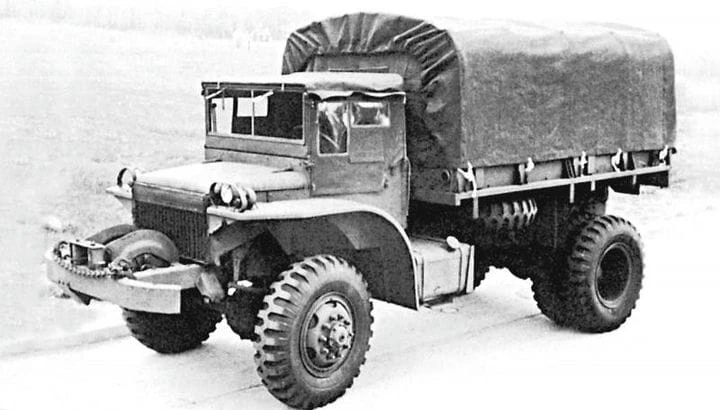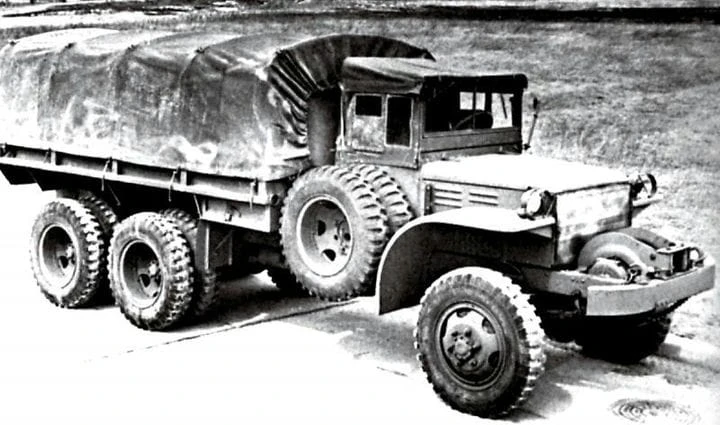Electric hybrids, rotating frames and huge wheels: the most unusual cars of World War II
Opening this article, it is difficult to imagine the most amazing self-propelled designs from different countries that no one has ever heard of. Some used wheels and tracks at the same time as engines and bulky tractors on huge drums with spurs that broke in half. Others admired the gas-electric exoticism, and the Americans decided how to quickly turn large army trucks into small ones.
Wheels and tracks are inseparable
In the second half of the 1930s. Tracked all-terrain vehicles were considered, capable of conducting short-term reconnaissance and combat operations on rough or mountainous terrain, moving along two tracks drawn into the body or standing on four of their own retractable wheels, the first in the field of light military off-road vehicles.
The Czechoslovak V377 tractor based on the Tatra-25 truck with two short-track propellers and rear drive wheels mounted on both sides of the tracks is considered to be similar to the tracked vehicles of the future. But soon the championship passed to the neighboring country.
Expert V377 truck tractor with 120 hp engine and longitudinal balancers on both sides of each track. 1930
In March 1938, peace-loving Austria was annexed by Germany. All military equipment came under the control of the Wehrmacht, and the production of most light combined vehicles was stopped. In the armies of other countries, such unusual military equipment did not exist at all.
Austro-Daimler products (1935-1938/1940)
The first classic ADMK tracked vehicle was equipped with a 20-horsepower air-cooled rear engine and a central steering column. Movement on the ground was provided by a shortened caterpillar propeller on a spring suspension with a front sprocket installed under the bottom of the body of all versions and allowing braking.
In preparation for highway driving, the rear of the car was lifted manually to allow detachable rubber wheel rollers with special locks to be suspended from each side of the car.
Military all-terrain vehicle “Austro-Daimler ADMK” with the tracks lowered to the ground and the rear rollers removed. 1935
ADMK trolley with tracked transmission raised and rollers lowered for delivering an anti-tank gun. 1937
Some versions were adapted for the installation of machine guns and the supply of 47 mm guns. Their speed on wheels reached 45 km / h, on tracks – 15 km / h. A total of 334 vehicles were built.
In the Wehrmacht, this installation received the WARK index and at the first stage was used in a half-track version as a tractor for towing guns with a caliber of up to 105 mm. Since 1940, four-door bodies were installed on it in the form of a tub for the driver and four members of the combat crew, as well as two people in the seats between the front wheels.
Version of the WARK, modified according to the requirements of the Wehrmacht, with a central steering wheel and seven seats for military personnel. 1940
Saurer Corporation Products (1936-1942)
The most practical all-terrain vehicles of this type were considered the RR (Rader-Raupen) series with two external tracks and four lifting wheels manufactured by a subsidiary of the Swiss company Saurer. The first RR6 prototype with trailing arm flat body was introduced in November 1936.
Experimental car Saurer RR6 with spaced tracks and a body with three rows of transverse seats. 1936
Subsequently, Saurer produced a 1.5-ton version of the RR7 with a 70 horsepower diesel engine, front steering and hydraulic brakes. The caterpillar propellers consisted of narrow toothed belts, a front toothed drive drum and separate helical suspension springs mounted for rotation on a common frame.
Fighting vehicle Saurer RR7 / 2 with hinged doors in the rear wall of the armored hull and front steering wheels. 1939
Tracked armored vehicles RR7 / 2 became one of the few Austrian military all-terrain vehicles that the Wehrmacht command evaluated and adopted under the designation Sd.Kfz.254. RR7 series machines were assembled in 160 units, some samples were delivered to the Czech Republic, Yugoslavia and the USSR.
The only Austrian tracked vehicle fully built after German accession was the simplified and practical Saurer M/K for the airborne troops, with a crew of five to seven crew members. The first version appeared in May 1939, two more machines were built in July 1941.
They were equipped with a 45 hp air-cooled engine, extended propellers with front-wheel drive gear and rear-wheel drive drums with removable wheel joints. Here, the process of replacing the stroke was greatly facilitated, which was carried out by pressing the caterpillar belts under the bottom along with the support drums.
Machine “Steyr M / K” for the Wehrmacht with front suspension on transverse springs, underground rails and wheels of different calibers. 1940
The second version of the M / K with the original five-seater body with a canvas top and a folding spare wheel. 1941
According to the test results, the conventional caterpillar tractor turned out to be the most preferable. These disappointing results led to the cessation of further work on complex, difficult and costly military curiosities.
The first articulated all-terrain vehicles
Bernard TT-4 (1937-1940)
A boldly designed reconnaissance vehicle TT-4 (4×4) from the French company Bernard. It was the original 55 hp mid-drive articulated car, born from an idea by Hungarian designer Nicholas Strausler, who in turn was licensed by the Italian company Pavesi.
The car consisted of two triple sections, connected by a longitudinal rigid pipe with a central hinge, around which it rotated in a vertical plane. The very first tests showed the impotence of an all-terrain vehicle too heavy on the ground. Later, the same fate befell the armored personnel carrier.
Two-section six-seater multi-purpose military vehicle Bernard TT-4 with two “broken” sections. 1938
Experienced armored vehicle TT-4 with a mid-engine mount, all-wheel drive and an articulated rear. 1940
Pavesi (1923/1931-1942)
At the end of the First World War, the self-taught Italian engineer Hugo Pavesi in his workshop began to create the then unpublished two-section off-road tractors P4 (4 × 4), which were then produced for almost 20 years. The first 25-horsepower tractors appeared in 1923, but it was not possible to organize their assembly. In 1931, the production of these cars was transferred to SPA, which began to produce cars of the P4.30 series with engines of 28-48 forces. They entered service as light artillery tractors for towing 75–150 mm guns.
Pavezi R4.30 tractor with 48 hp engine and single cast wheels with folding blocks. 1934
The sections of these machines were interconnected by a hinge, which made it possible to change the relative position in both planes. The original solutions were continuous drive axles, a rigid longitudinal drive shaft that acted as a thrust frame, a rotating device driven by a conventional steering wheel, large-diameter single drive wheels with cast tires and folding spurs.
Two-section light military vehicle TL31 with a crew of six and single tires for work in mountainous terrain
Pavesi P4.31 (L140) refurbished 55 hp military tractor with double road wheels and hand winch. 1930
The bases of both sections were frames made of U-shaped profiles up to 200 mm high. The front housed the engine and an open double cabin with a canvas top, the rear was used to transport soldiers and cargo. Individual suspension was provided by vertical springs built into the hubs with a diameter of up to one and a half meters.
In 1924, a more powerful P4.100 tractor was developed with new 45-57 hp engines and differential locks. It had a spring suspension mounted in the central hinge of the winch, metal wheels with a diameter of 1.6 meters with solid tires (in the 30s – with tires). The car developed a speed of 22 km / h and pulled towed trains weighing up to 75 tons.
The most powerful artillery tractor P4.100 with a 55 hp engine for towing heavy artillery pieces. 1937
Tractor Pavesi P4.100 with a crew of eight, including two coupling devices, at a military parade on the central square of Helsinki
And although in practice such complex machines turned out to be too heavy, slow and clumsy, they were widely used in the mountainous parts of the Italian armed forces. They entered the armies of Germany, Hungary and Finland, Great Britain and Sweden acquired a license for them, and the Hungarian engineering company Manfred Weiss produced 106 Weiss-Pavesi tractors with a 40-horsepower engine.
A heavy Weiss-Pavesi P4.100-28M tractor with metal wheels pulls a 150mm howitzer over rough terrain.
Amazing Uniques
Garner G3 (1938-1939)
The fame of the small British company Garner brought light trucks G3 (4×4) with an extended engine compartment, in which two Ford V8 engines with 85 hp each stood side by side. Depending on road conditions, the transmission can be configured to send torque to all four wheels, to both sides of the machine, or to just one axle.
A 170 horsepower Garner G3 single-slope twin-cylinder tractor that sent power to its gearboxes and axles. 1938
Tilling-Stevens TS20 (1939-1942)
In the first year of the war, Tilling-Stevens began production of three-ton (4×2) TS20 trucks with a hybrid gasoline-electric drive, designed to serve 90 mm lighting stations.
Tilling-Stevens TS20 combat truck with a special electric generator for anti-aircraft headlights (photo by the author)
On 70 hp half-hood vehicles, a 24 kW electric generator and a traction motor of the same power were driven in combination with three- and four-speed gearboxes with two-speed gearboxes. Depending on the purpose, the self-propelled headlamp was produced in four versions with different body and transmission options.
RSO code (1942-1944)
At the end of 1942, at the Skoda plant in Mladá Boleslav, the first samples of the all-wheel drive “East Wheel Tractor” (Radschlepper Ost, RSO), developed by Ferdinand Porsche's design bureau as the Porsche-175 project, were assembled. It was designed to carry 12 soldiers with weapons and work in many frosts, deep snow and off-road conditions.
Unusual multi-purpose tractor Ŝkoda RSO of the first sample with steel 1.5-meter wheels and high fins. 1942
The RSO vehicles were equipped with a German air-cooled 90 hp four-cylinder gasoline engine, five-speed transmission, center differential locks and two pairs of drive shafts to drive bevel gears at each wheel. To start the car in severe frost, it took a 12-horsepower unit assembled from the engine half of a Volkswagen car.
In 1943-1944, 196 tractors were built in the Czech Republic and sent to the eastern and western fronts.
USA: beyond recognition and uselessness (1942-1944)
During World War II, Secret Cars in America were custom-designed single vehicles deemed useless in combat. Here we are going to talk about some low profile 4WD trucks with low main parts and load capacity from 750kg to 3t.
In 1942, eight American military equipment manufacturers adopted the design of the so-called Low Silhouette project – compact vehicles that were less visible during reconnaissance on the front lines. In simpler modifications, cabs, folding windshields, steering columns, sides, as well as smaller wheels and tires were removed from regular cars.
The most running 1.5-ton low-profile Ford GTBA car on units from the G8T military rear-wheel drive truck with a 90-horsepower engine and a metal body, 2218 vehicles were produced.
Chevrolet G7129 fully open truck based on the G7100 family with 89 horsepower engine, low engine bay, flip-down windshield with wipers and slatted top.
Universal compact self-propelled platform Studebaker LC in the form of a wagon with an underground compartment for 109 seats and a drop-down front central wheelhouse with a folding windshield frame.
A more complex version of the changes was expressed in the use of new power units and drives, the expansion or narrowing of bodies and cabs, a reduced location of the driver's workplace, a compact arrangement of seats and engines in the cab, as well as spare wheels in wood-metal and steel boxes with several longitudinal and removable benches for transporting military personnel.
International Harvester introduced the three-ton DF M-6-4 tractor with a separate driver's seat open on the left and a 111 hp engine mounted next to it, as well as a seven-seater body with two spare wheels.
Compact three-ton GMC DAK with a 91 hp engine for transporting 12 soldiers, equipped with a narrow cab with a strong awning for attaching one or two spare wheels to the door on the right side of the vehicle.
A unique REO LS-60F semi-armored truck with an open front engine for 106 forces, an all-metal body with top protective covers and a spare tire in the side niches.
In 1942-1943, the main car manufacturers submitted their developments for competitive tests, which lasted until mid-1944. As a result, more radical modifications of the army were not satisfied. In 1944, when the urgent need for mass deliveries of military equipment began to decrease, the “low-profile project” was closed and did not resume after the war.
Three-axle expert truck International DF M-5-6 with a load capacity of three tons, an open cab with an overall height of 1.8 meters along the edge of the steering wheel and an attachment for a detachable machine gun turret.
The GMC DAKW army truck with a narrow cab and two reinforced spare wheels, designed to carry 16 soldiers, weighing 2.5 tons, was equipped with power units of the two-axle DAK model.
The most expensive of the four 2.5-ton low-profile Studebaker vehicles was the lightest, lowest and most practical 109-horsepower truck LD-162 on a chassis with a base extended to 4.1 meters.
